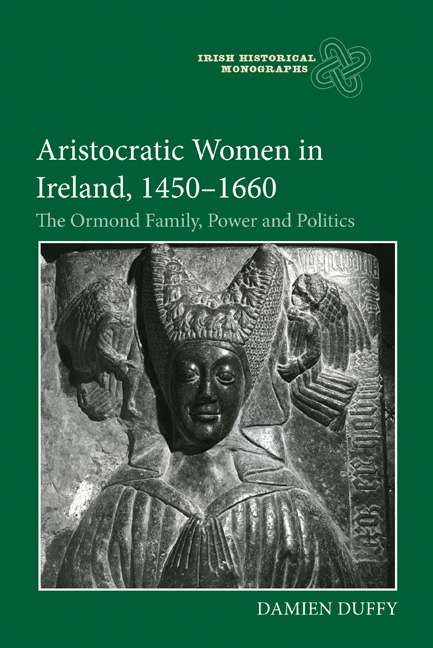Book contents
- Frontmatter
- Dedication
- Contents
- Preface
- Acknowledgements
- List of Abbreviations
- Introduction
- 1 Aristocratic Women’s Lives in Late Medieval and Early Modern Western Europe
- 2 The Ormond Women Through the Wars of the Roses and Immediate Aftermath: Marriage, Absenteeism and Illegitimacy
- 3 New Beginnings: The Heiresses, the Usurper and Royal Intervention – the Succession of Margaret and Anne Butler
- 4 Dynastic Consolidation and Female Political Entity: Margaret Fitzgerald, Countess of Ormond and Ossory (1472–1542)
- 5 Family, Marriage and Politics: The six Daughters of Margaret Fitzgerald and Piers Butler and the Ongoing Revival of the Earldom in the Sixteenth Century
- 6 ‘You have too Piteous a Face to be a Warrior’: Joan Fitzgerald, Countess of Ormond, Ossory and Desmond – Agent, Peace Broker, Advocate
- 7 Black Tom’s Women: Unions, Succession and Decline
- Conclusion
- Bibliography
- Index
- Irish Historical Monographs Previous Volumes
4 - Dynastic Consolidation and Female Political Entity: Margaret Fitzgerald, Countess of Ormond and Ossory (1472–1542)
Published online by Cambridge University Press: 26 March 2021
- Frontmatter
- Dedication
- Contents
- Preface
- Acknowledgements
- List of Abbreviations
- Introduction
- 1 Aristocratic Women’s Lives in Late Medieval and Early Modern Western Europe
- 2 The Ormond Women Through the Wars of the Roses and Immediate Aftermath: Marriage, Absenteeism and Illegitimacy
- 3 New Beginnings: The Heiresses, the Usurper and Royal Intervention – the Succession of Margaret and Anne Butler
- 4 Dynastic Consolidation and Female Political Entity: Margaret Fitzgerald, Countess of Ormond and Ossory (1472–1542)
- 5 Family, Marriage and Politics: The six Daughters of Margaret Fitzgerald and Piers Butler and the Ongoing Revival of the Earldom in the Sixteenth Century
- 6 ‘You have too Piteous a Face to be a Warrior’: Joan Fitzgerald, Countess of Ormond, Ossory and Desmond – Agent, Peace Broker, Advocate
- 7 Black Tom’s Women: Unions, Succession and Decline
- Conclusion
- Bibliography
- Index
- Irish Historical Monographs Previous Volumes
Summary
Piers Ruadh Butler, eighth earl of Ormond and his wife, Margaret Fitzgerald, undertook the transformation of the earldom in Ireland and established the first home-based control of the dynasty for almost seventy years, since the days of the white or fourth earl of Ormond in the early fifteenth century. The new countess, resident in the heart of the earldom, assumed a higher profile than any of her predecessors and this was achieved as much through her physical presence in the earldom as through her political acumen and strong personality. Margaret influenced the transformation of the patrimony that she and her husband inherited, to the family's benefit, and she enhanced the succession and security of the dynasty, being as firmly focused on proving Piers's legitimate claim to the Ormond inheritance as she was on providing for their offspring. She played an active part in the drive to have her husband's claim to the earldom in Ireland recognised by the Dublin parliament in 1517 and was an important interlocutor between the two most powerful and political aristocratic Old English families in the lordship.
Despite the availability of contemporary sources concerning Margaret, notably the writings of Richard Stanihurst, the state papers, her correspondence with King Henry VIII and a handful of documents among the Ormond deeds, it was not until the publication of the writings of James Graves and J. G. A. Prim in the nineteenth century that she became the subject of scholarly study. More recently, entries in both the Oxford Dictionary of National Biography and the Dictionary of Irish Biography attest to recognition among modern scholars of her importance in Tudor Ireland: this study seeks to deepen an understanding of her significance.
Although neither the exact date nor location of her birth is recorded, it is probable that Margaret, daughter of Gearóid Mór Fitzgerald, the ‘Great Earl’ of Kildare, was born at Maynooth Castle in County Kildare. The second of six daughters of the eighth earl and his first wife, Alison FitzEustace, she is understood to have been born in 1472 and was described by the Dublin-born Old English chronicler and Geraldine supporter, Richard Stanihurst, as ‘the fairest daughter of the earl of Kildare’.
- Type
- Chapter
- Information
- Aristocratic Women in Ireland, 1450-1660The Ormond Family, Power and Politics, pp. 76 - 104Publisher: Boydell & BrewerPrint publication year: 2021

